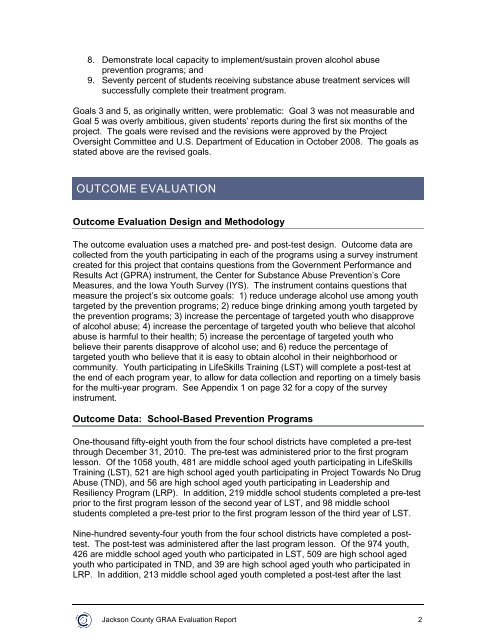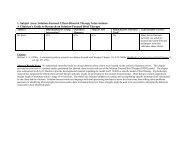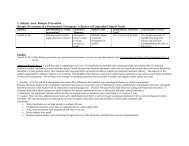Jackson County Program Evaluation Project Year 3, Report 1.pdf
Jackson County Program Evaluation Project Year 3, Report 1.pdf
Jackson County Program Evaluation Project Year 3, Report 1.pdf
Create successful ePaper yourself
Turn your PDF publications into a flip-book with our unique Google optimized e-Paper software.
8. Demonstrate local capacity to implement/sustain proven alcohol abuseprevention programs; and9. Seventy percent of students receiving substance abuse treatment services willsuccessfully complete their treatment program.Goals 3 and 5, as originally written, were problematic: Goal 3 was not measurable andGoal 5 was overly ambitious, given students’ reports during the first six months of theproject. The goals were revised and the revisions were approved by the <strong>Project</strong>Oversight Committee and U.S. Department of Education in October 2008. The goals asstated above are the revised goals.OUTCOME EVALUATIONOutcome <strong>Evaluation</strong> Design and MethodologyThe outcome evaluation uses a matched pre- and post-test design. Outcome data arecollected from the youth participating in each of the programs using a survey instrumentcreated for this project that contains questions from the Government Performance andResults Act (GPRA) instrument, the Center for Substance Abuse Prevention’s CoreMeasures, and the Iowa Youth Survey (IYS). The instrument contains questions thatmeasure the project’s six outcome goals: 1) reduce underage alcohol use among youthtargeted by the prevention programs; 2) reduce binge drinking among youth targeted bythe prevention programs; 3) increase the percentage of targeted youth who disapproveof alcohol abuse; 4) increase the percentage of targeted youth who believe that alcoholabuse is harmful to their health; 5) increase the percentage of targeted youth whobelieve their parents disapprove of alcohol use; and 6) reduce the percentage oftargeted youth who believe that it is easy to obtain alcohol in their neighborhood orcommunity. Youth participating in LifeSkills Training (LST) will complete a post-test atthe end of each program year, to allow for data collection and reporting on a timely basisfor the multi-year program. See Appendix 1 on page 32 for a copy of the surveyinstrument.Outcome Data: School-Based Prevention <strong>Program</strong>sOne-thousand fifty-eight youth from the four school districts have completed a pre-testthrough December 31, 2010. The pre-test was administered prior to the first programlesson. Of the 1058 youth, 481 are middle school aged youth participating in LifeSkillsTraining (LST), 521 are high school aged youth participating in <strong>Project</strong> Towards No DrugAbuse (TND), and 56 are high school aged youth participating in Leadership andResiliency <strong>Program</strong> (LRP). In addition, 219 middle school students completed a pre-testprior to the first program lesson of the second year of LST, and 98 middle schoolstudents completed a pre-test prior to the first program lesson of the third year of LST.Nine-hundred seventy-four youth from the four school districts have completed a posttest.The post-test was administered after the last program lesson. Of the 974 youth,426 are middle school aged youth who participated in LST, 509 are high school agedyouth who participated in TND, and 39 are high school aged youth who participated inLRP. In addition, 213 middle school aged youth completed a post-test after the last<strong>Jackson</strong> <strong>County</strong> GRAA <strong>Evaluation</strong> <strong>Report</strong> 2






